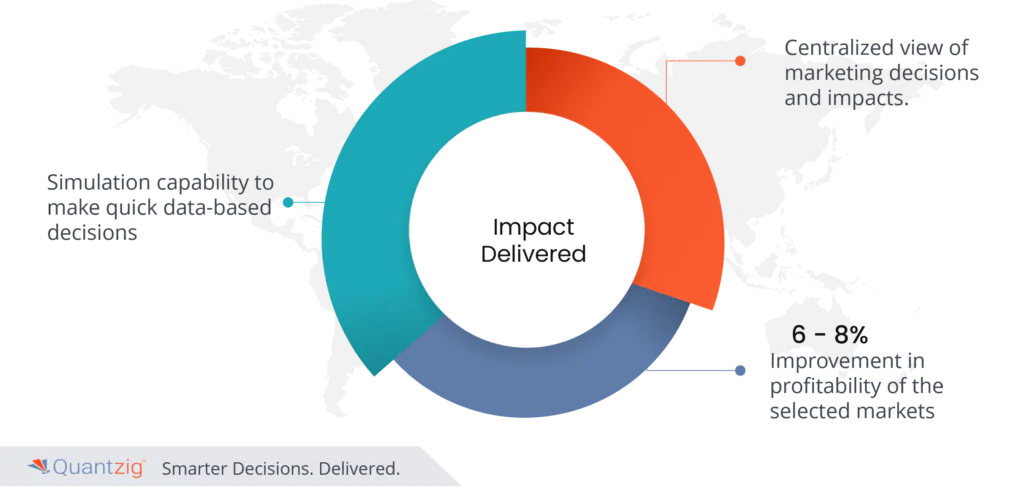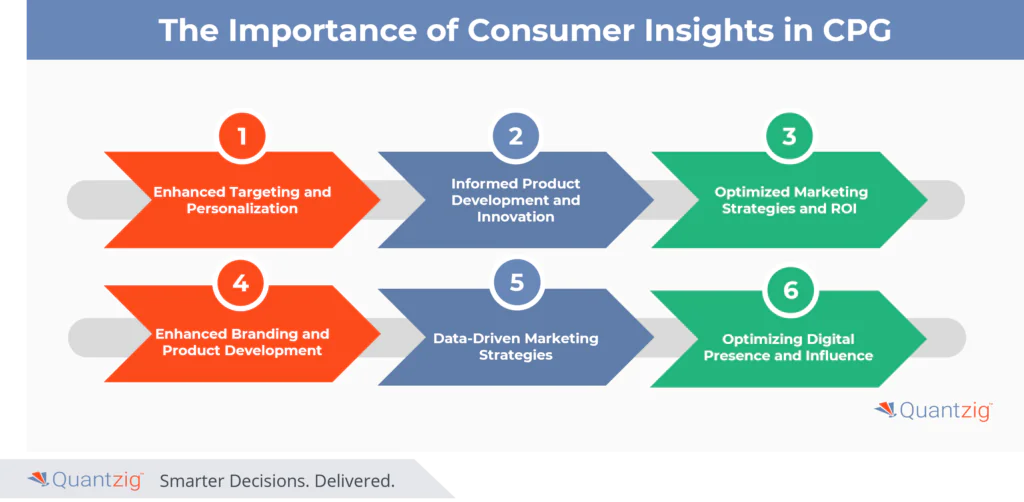Table of Contents
Introduction to Marketing Analytics for CPG Industry
In an era of unprecedented technological advancements and evolving consumer behavior, the Consumer-Packaged Goods (CPG) industry finds itself at a crossroads, navigating a landscape where traditional marketing strategies are no longer sufficient for sustainable growth. The future of marketing in the CPG sector is undergoing a profound transformation, where innovative approaches are not just an option but a necessity.
As CPG marketers seek to maximize their Marketing Return on Investment (MROI), the convergence of Marketing Mix Modeling (MMM) and Multi-Touch Attribution (MTA) stands as a beacon of hope. This article delves deep into the cutting-edge strategies that promise to revolutionize the CPG industry, redefining how brands connect with consumers, optimize their marketing efforts, and ultimately thrive in a dynamic marketplace.
Book a demo to experience the meaningful insights we derive from data through our CPG marketing strategy and platform capabilities. Schedule a demo today!
Request a Free DemoHow Quantzig applied Marketing Analytics to create a Success Story?
| Client Details | Multinational CPG giant based in the USA with $1Bn+ revenue. |
| Challenges | Revenue growth didn’t align with increased budget allocation; needed analysis of marketing channels. |
| Solutions Offered | Quantzig provided a sophisticated model for cross-channel comparisons and correlations. |
| Impact Delivered | – 6-8% profitability improvement in selected markets. <br> – Quick, data-based decision-making. <br> – Centralized view of marketing decisions and impacts. |
Client Details:
A multinational CPG giant headquartered in the USA with annual revenue of $1Bn+.
Challenges faced by the client:
The client’s challenge stemmed from their investment in both personal and non-personal marketing channels, as they sought to drive revenue growth. However, the client noticed that the revenue increase did not align proportionally with the increased budget allocation. This disconnect prompted the need for a comprehensive analysis of the various marketing channels to ascertain their individual impacts on revenue.
To address this issue effectively, the client aimed to optimize budget allocation, ensuring that resources were channeled into strategies and channels with the highest potential for revenue generation. Such an analysis involved a deep dive into the performance of each marketing channel, both personal (such as sales representatives, and direct interactions) and non-personal (like digital advertising, social media, and other automated touchpoints). By understanding the specific contribution of each channel, the client could make data-driven decisions to allocate resources more efficiently, thus maximizing revenue growth while maintaining budgetary discipline. This analytical approach is crucial for achieving a balanced and optimized marketing strategy that drives the desired revenue outcomes.
Solutions offered by Quantzig:
Quantzig, recognizing the leadership team’s need for data-driven decision-making, embarked on a comprehensive project that addressed five critical business questions. The project involved the creation of a sophisticated model capable of accounting for marketing activities across various channels, allowing for cross-channel comparisons and insightful correlations.
The culmination of this effort was a dynamic dashboard that offered the leadership team immediate access to answers for their key business inquiries with just a few clicks. This dashboard acted as a centralized hub, providing a holistic view of marketing impact and financial outcomes, empowering stakeholders to analyze data across different variables and explore multiple business scenarios.
The ability to slice data across various levers and simulate scenarios streamlined the decision-making process significantly. This not only expedited the decision-making process but also improved operational efficiency by ensuring that resources were allocated optimally based on data-driven insights. By providing a user-friendly interface to explore and simulate diverse scenarios, Quantzig’s solution transformed the leadership team’s approach to strategy and decision-making, enabling them to make informed, impactful choices swiftly and effectively.
Get started with your complimentary trial today and delve into our platform without any obligations. Explore our wide range of customized, data driven CPG analytical solutions built across the analytical maturity levels.
Start your Free TrialImpact Delivered using Quantzig’s Expert Market Analytics Solutions:

- 6 – 8% improvement in profitability of the selected markets.
- Simulation capability to make quick data-based decisions
- Centralized view of marketing decisions and impacts.
What is Marketing Analytics for CPG Industry?

Consumer goods landscape presents unique challenges necessitating innovative marketing strategies. Yet, traditional methods like billboard advertising remain relevant for broad audience exposure. A data-driven approach underpins decision-making, while mobile-friendly websites facilitate seamless interactions. Omnichannel strategies blend experiential marketing with organic tactics, ensuring holistic brand experiences. Today, success hinges on agile adaptation and strategic alignment with evolving consumer preferences.
Marketing Analytics for CPG Industry revolves around leveraging CPG Data Analytics to drive success for CPG brands in the competitive market landscape. By analyzing customer behavior, retailer data, and sales data, CPG companies tailor their strategies to meet consumer demands effectively. Utilizing insights from inventory information and distributor data, they optimize product availability and distribution channels. Additionally, incorporating panel/syndicated data and insights from market research companies informs data-driven decisions, facilitating a cycle of continuous improvement. Through strategic sales and marketing initiatives, CPG brands capitalize on observational data and retail data to optimize stock levels and drive business growth in the dynamic CPG industry.
Importance of Innovative Strategies for MROI Optimization, MMM, and MTA in the CPG Industry
The Consumer-Packaged Goods (CPG) industry is currently undergoing a significant shift in its marketing approach, driven by several factors. This transformation stems from the changing landscape of industry trends and market dynamics, as well as the growing need for real-time decision intelligence, especially in Search Engine Optimization (SEO) and Direct-to-Consumer (D2C) channels.
Historically, CPG marketing has revolved around long-term strategic planning, with brands carefully allocating resources across different channels based on traditional models and historical data. However, the emergence of digital platforms and E-commerce has made real-time decision-making indispensable. Particularly in SEO and D2C channels, brands must swiftly adapt to evolving consumer trends and market conditions.
This shift in approach necessitates a comprehensive integration of various strategies and technologies to stay ahead in the competitive landscape. Leveraging customer intelligence and AI solutions is becoming essential for understanding consumer behavior and optimizing marketing efforts. The utilization of a Marketing technology stack, including tools for Data-driven marketing and E-commerce, facilitates seamless execution and measurement of marketing strategies.
Moreover, implementing Dynamic creative optimization (DCO) and Digital asset management (DAM) ensures that marketing assets resonate effectively with diverse consumer segments. Embracing a Consumer-centric strategy enables brands to prioritize customer needs and preferences, fostering long-term customer loyalty.
In this evolving marketing environment, the role of KPIs (Key Performance Indicators) becomes crucial for evaluating the success of marketing initiatives and refining strategies accordingly. Adopting Modern marketing practices and cultivating a Performance-driven marketing organization mindset empowers CPG marketers to navigate the changing landscape effectively.
In summary, the CPG industry’s marketing paradigm is shifting towards a more dynamic and data-driven approach. By embracing innovative technologies and strategies such as, Marketing organization, Martech (Marketing Technology), Customer-data platform (CDP), influencer marketing, content marketing, and paid social media marketing, brands can position themselves for success in today’s competitive market.
Efficient marketing management solutions that bridge the gap between these two contrasting demands have become a critical strategic asset for brand marketers in the CPG sector. These marketing organization solutions integrate data analytics, AI solutions, artificial intelligence, and real-time monitoring, allowing brands to make agile and data-driven decisions, allocate resources dynamically, and maximize their ROI.
In essence, CPG marketers must strike a delicate balance between long-term planning and real-time adaptability to navigate the modern marketing landscape successfully. Those who invest in such efficient management solutions are better equipped to thrive in this ever-evolving industry, ensuring their brands remain competitive and responsive to the needs of today’s consumers.
Implementing Dynamic creative optimization (DCO) and Digital asset management (DAM) ensures that marketing assets are tailored to resonate with diverse consumer segments. Embracing a consumer-centric strategy allows brands to prioritize the needs and preferences of their audience while tracking KPIs (Key Performance Indicators) enables evaluation of marketing initiatives and refinement of strategies for continuous improvement.
The Importance of Consumer Insights in Marketing Analytics for CPG Industry

Consumer insights are the cornerstone of successful marketing strategies, especially in the dynamic landscape of Consumer Packaged Goods (CPG) marketing. By leveraging a data-driven approach, brands can gain invaluable insights into consumer behavior and preferences, guiding decision-making processes across various facets of their operations. From enhancing online presence and driving e-commerce growth to fostering sustainability and catering to health and wellness trends, consumer insights inform every aspect of CPG marketing.
Through personalization, social media influence, and engaging video content, brands can effectively connect with their target audience, leveraging consumer feedback to refine their offerings and strategies.
- Enhanced Targeting and Personalization: Consumer insights are invaluable in understanding the diverse preferences and purchasing behaviors within the CPG industry. By leveraging insights derived from market research and consumer packaged goods, marketers can tailor online marketing and social media marketing efforts to specific demographics and segments. This level of targeting fosters brand loyalty by delivering relevant content and product offerings to consumers, thereby maximizing engagement and driving ecommerce sales across various channels.
- Informed Product Development and Innovation: Consumer insights provide CPG brands with a deep understanding of evolving consumer needs and desires across categories like food, beverages, household products, and beauty and personal care products. This knowledge fuels product development trends and innovation, enabling brands to introduce new products or reformulate existing ones to better meet consumer demands. By staying attuned to consumer preferences, brands can maintain a competitive edge in the market and capitalize on emerging opportunities, especially in areas like over-the-counter healthcare products.
- Optimized Marketing Strategies and ROI: In an increasingly competitive landscape, consumer insights guide strategic decision-making in digital marketing and advertising campaigns for CPG brands. By understanding consumer behavior patterns and preferences, marketers can create targeted and compelling content through content marketing, maximizing the effectiveness of marketing initiatives. This results in improved ecommerce performance and sales outcomes, particularly in supermarkets, grocery stores, and mass merchandise retailers. Moreover, consumer insights facilitate market research-driven optimizations, ensuring that marketing efforts yield a higher ROI and drive sustainable growth for CPG brands.
- Enhanced Branding and Product Development: Consumer insights serve as a guiding light in branding and product development within the CPG industry. By delving into consumer behavior and preferences, brands can tailor their offerings to align with market demands and emerging market trends. These insights inform decisions related to pricing, distribution, and product features, ensuring that products resonate with consumers and stand out amidst competitors. With a deep understanding of customer feedback and preferences, brands can refine their offerings to foster customer engagement and build lasting customer loyalty.
- Data-Driven Marketing Strategies: In today’s data-driven landscape, consumer insights are essential for crafting effective CPG marketing strategies. By leveraging data analytics tools like Mailchimp, brands can segment their audience effectively and deliver personalized marketing campaigns tailored to individual preferences. Utilizing marketing tools and CRM platforms enables brands to streamline communication channels and enhance customer engagement across various touchpoints, including social media platforms. This approach fosters meaningful interactions with consumers and drives measurable ROI through targeted digital advertising and traditional methods like billboard advertising and paid social media marketing.
- Optimizing Digital Presence and Influence: Consumer insights play a pivotal role in optimizing a brand’s digital presence and influence. By understanding consumer behavior and preferences, brands can fine-tune their SEO strategies to enhance visibility on search engine results pages. Moreover, insights into consumer preferences facilitate strategic decisions regarding influencer marketing, ensuring collaborations resonate with target audiences. By embracing social media management software, brands can monitor and respond to consumer sentiment effectively, fostering positive interactions and enhancing brand perception. Through personalized marketing campaigns and targeted engagement efforts, CPG brands can leverage consumer insights to strengthen their position in the market and drive sustainable growth.
In conclusion, the importance of consumer insights in CPG marketing cannot be overstated. As brands navigate the complexities of the modern marketplace, understanding consumer preferences and behaviors is essential for driving success. By prioritizing consumer insights, CPG brands can stay ahead of market trends, adapt to evolving consumer preferences, and secure their position as leaders in the industry.
Why choose Quantzig while implementing Marketing Analytics for CPG Industry
Within Consumer Packaged Goods (CPG) marketing practices, it is not merely about individual initiatives; it’s about the orchestration of multiple successful campaigns operating in tandem. From pioneering product innovation to fine-tuning pricing optimization, from crafting compelling digital marketing strategies to enhancing distribution channels, every facet contributes to incremental growth. However, understanding the impact of these steps demands a unified perspective for precise return on investment (ROI) attribution.
In CPG Marketing, where brands vie for consumer attention across a plethora of categories such as groceries, health and personal care items, household products, and beverages, leveraging data analytics is main ingredient. It’s helps you in unlocking insights that guide the creation of personalized marketing campaigns tailored to individual preferences. With the omnipresence of social media platforms and the ever-evolving algorithms of search engine optimization (SEO), mastering digital advertising is indispensable for staying ahead in this competitive arena.
Moreover, the analytical techniques employed must be refined to accommodate the interplay of various strategies and their collective impact on sales and revenue. Establishing a cohesive measurement framework mandates efficient change management processes to ensure organizational adaptability to the new measurement paradigm.
By integrating online advertising and display advertising alongside traditional methods such as billboard advertising, CPG brands can enhance customer engagement and foster brand loyalty. A robust online presence coupled with strategic ecommerce sales promotion and social media marketing amplifies brand values in a dynamic market environment. Implementing tailored e-commerce strategies and innovative digital marketing tactics complemented by targeted email campaigns further solidifies brand positioning and drives growth in the competitive CPG landscape.
In summary, driving incremental volumes within CPG through multiple revenue excellence strategies demands a holistic and unified approach to measurement. This requires data-intensive efforts, sophisticated analytics, and meticulous change management to accurately attribute success and inform future strategy development. Additionally, it involves leveraging consumer feedback and understanding consumer behavior to ensure sustainability and responsibly sourced ingredients are integrated, meeting the rising demand for health and wellness products. Utilizing clear product labels and incorporating eco-friendly materials, personalization, natural and organic ingredients cater to consumer preferences, while offering personalization options based on age, location, and gender enhances the enjoyable shopping experience.
Experience the advantages firsthand by testing a customized complimentary pilot designed to address your specific CPG marketing strategy requirements. Pilot studies are non-committal in nature.
Request a Free PilotHow Marketing Analytics for CPG can Improve Efficiency in the Field?
CPG Data Analytics plays a pivotal role in enhancing efficiency in the field by leveraging DIY data pipelines and advanced methods to streamline distribution and supply chain operations. Utilizing CPG Analytics Tools and BI tools like Tableau and PowerBI, CPG companies adopt a data-driven approach to optimize sales and marketing strategies while fostering a cycle of continuous improvement.
By analyzing observational data and stock levels, they identify competitive activity and ensure promotional compliance, enabling them to take specific actions that have the highest impact on sales. Moreover, by monitoring volume of products sold and store locations, they mitigate out of stocks and ensure compliance across all aspects of their operations, ultimately driving efficiency and success in the field.
CPG Data Analytics empowers field efficiency by utilizing predictive tools to optimize operations in high-volume stores. By translating data into actionable insights through data stories, companies track KPIs such as sales volume and monitor new and churned accounts to address issues like out of stocks and ensure compliance. This comprehensive approach enables CPG companies to maximize efficiency in the field, driving sales and fostering growth in a competitive market environment.
Benefits of implementing Marketing analytics for CPG Industry
Our Marketing Decision Management (MDM) framework stands as a comprehensive solution, empowering brands to quantify and optimize the impact of their marketing activities. To stand up in today’s competition, inducing the true ROI of marketing endeavors is important for strategic decision-making. Our MDM framework achieves this through a multi-faceted approach. Employing a laddered mode of measurement, we amalgamate both top-down and bottom-up perspectives. The top-down analysis enables us to glean commercial insights by scrutinizing the macro-level influence of marketing campaigns on overall brand performance, offering a holistic perspective on how marketing investments influence business outcomes.
Furthermore, our framework is tailored to integrate sustainability initiatives and sustainable practices, ensuring brands align their marketing efforts with ethical and environmental considerations. By optimizing the marketing mix and strategically leveraging retail media campaigns, brands can enhance their omnichannel strategies and foster relationships with retailers to maximize product subscriptions and net sales value.
With the rise of voice search and the importance of online marketing presence, our framework harnesses cutting-edge AI engine technology to drive results. Moreover, by incorporating zero party data and consumer intelligence engines, brands gain unparalleled insights into consumer behavior, product reviews, enabling the implementation of effective experiential marketing and organic marketing tactics.
Even in offline marketing strategies, our framework shines, providing data-driven solutions to maximize impact. With a focus on CPGs (Consumer Packaged Goods), our framework ensures brands stay ahead of the curve, adapting to changing consumer preferences and market dynamics. Whether online or offline, our MDM framework empowers brands to make informed business decisions, driving sustainable growth and fostering long-term success.
In contrast, our bottom-up approach delves into the granular details of digital attributions and consumer behavioral impact. This perspective enables a deep understanding of how individual marketing touchpoints, channels, and campaigns influence consumer behavior and drive conversions. With the integration of Marketing talent, Consumer intelligence engine, retail data, consumer data, Cookies, First-party data, and Third-party data, our strategy is fortified. We leverage Retail media networks to enhance visibility and optimize outreach.
Our Tech stack facilitates seamless operations, while Agile practices and Cross-functional collaboration ensure nimble adaptation to market shifts. Within our Agile pods, Brand managers work hand in hand with Data-driven culture advocates, Leadership, and Data analytics teams to refine strategies in real-time. The synergy between the Creative function and data-driven insights empowers us to outpace the Competition.
Moreover, our framework leverages data-driven simulations to virtually measure the returns on media plans. This empowers brands to optimize their strategies, ensuring that marketing resources are allocated to the most effective channels and campaigns. By incorporating advanced analytics and modeling, we provide brands with the tools to make informed business decisions, maximize ROI, and adapt swiftly to the ever-changing marketing landscape.
How Quantzig Implements CPG Marketing Analytics Strategies?

In the dynamic CPG industry, crafting effective marketing strategies is paramount for CPG brands to thrive in the competitive consumer goods landscape. Leveraging the power of online marketing channels, including social media marketing and content marketing, facilitates reaching target audiences effectively. Strategic branding initiatives, coupled with innovative product development and pricing strategies, foster customer engagement and brand loyalty in a rapidly evolving market.
CPG Marketing Strategy encompasses the utilization of CPG Data Analytics to inform strategic decisions for CPG brands in response to customer preferences and market trends. By analyzing sales data and retailer data, CPG companies optimize product availability and distribution channels, leveraging insights from inventory information and distributor data. This facilitates a cycle of continuous improvement as they monitor observational data and retail data to manage stock levels effectively in the competitive CPG industry.
Consumer Insights and Engagement
In CPG marketing, understanding consumer behavior and garnering actionable consumer insights are foundational. Through strategic data analytics and leveraging tools like Mailchimp and marketing CRM, brands decipher customer feedback and preferences. Personalized marketing campaigns resonate with audiences, while social media management software enhances social media platforms engagement. Influencer marketing and search engine optimization (SEO) amplify brand visibility, driving digital advertising success.
Consumer Insights and Engagement are pivotal components of CPG Marketing Strategy, involving the utilization of CPG Data Analytics to understand customers and enhance engagement. By analyzing sales data and retailer data, CPG brands gain valuable insights into consumer behavior, preferences, and purchasing patterns. This informs targeted marketing efforts and product development strategies, leveraging inputs from inventory information and distributor data to optimize consumer engagement.
Sustainability and Health Focus
Amid shifting consumer preferences towards health and wellness, CPG brands pivot towards sustainable practices and offerings. Personalization and social media influence are pivotal in this paradigm shift, fostering consumer loyalty. Video content and consumer-generated product reviews enhance authenticity and trust. Retail media campaigns and omnichannel strategies ensure seamless website user conversions across platforms. With a focus on experiential marketing and organic tactics, brands navigate the evolving landscape while embracing opportunities for growth and innovation.
Sustainability and Health Focus are integral elements of CPG Marketing Strategy, encompassing a holistic approach to product development and marketing initiatives. This involves evaluating brand affinity and sales velocity to gauge consumer interest and prioritize sustainable offerings. Furthermore, promotion evaluation and in-stock performance analysis inform marketing tactics and ensure product availability. Incorporating broker management and insights from product development, CPG companies align order fulfillment and inventory planning with sustainability goals, fostering distribution growth while leveraging data analysis and automation solutions to support these efforts within data warehouses.
Offline and Legacy Brand Strategies
Even in the digital age, offline marketing strategies retain relevance for CPG brands, especially legacy brands. Consumer intelligence engines like Mediatool empower data-driven decision-making, maximizing ROI. Integrating big data insights into strategies informs targeted product subscriptions and retail media campaigns. Strategic utilization of online advertising complements offline efforts, ensuring holistic brand visibility and resonance.
Conclusion
In a rapidly evolving consumer landscape, the future of marketing within the Consumer-Packaged Goods industry demands innovative strategies for MROI optimization, embracing both Marketing Mix Modeling (MMM) and Multi-Touch Attribution (MTA). This visionary path offers the promise of unprecedented insights, efficiency, and growth. As CPG brands embrace data-driven decision-making, harnessing technology to understand consumer behavior, and refining their marketing investments, they position themselves to thrive in the digital era. The fusion of traditional wisdom with cutting-edge analytics paves the way for a brighter, more profitable future. The CPG industry’s transformation is not an option; it’s imperative for those who aspire to remain competitive and relevant.



